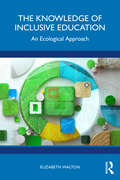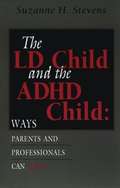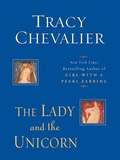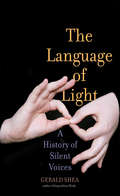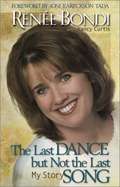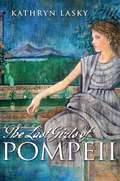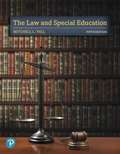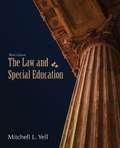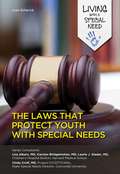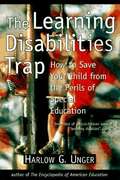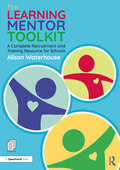- Table View
- List View
The Knowledge of Inclusive Education: An Ecological Approach
by Elizabeth WaltonThe Knowledge of Inclusive Education is a paradigm-shifting exploration of inclusive education as a dynamic knowledge practice. The knowledge that underpins the practice is understood through the metaphor of an ecology, with valuable contributions from educators, researchers, parents, students, policymakers, and international organisations.By examining the knowledge of policy, research, teacher education, and activism, Elizabeth Walton constructs a future for inclusive education that affirms different material-discursive places, inquiry, and possibility and replaces traditional research hierarchies with a life-affirming ecology. Readers will gain a novel perspective on the knowledge/s of inclusive education across multiple interacting domains.With theoretical resources ranging from the work of Lorraine Code and Basil Bernstein to concepts from Legitimation Code Theory, Decolonial theory, and Posthumanism, this book offers a unique and innovative approach to the multiple perspectives and knowledges that inform inclusive education policy and practice. Its conceptual and empirical research draws from several international contexts, ensuring that The Knowledge of Inclusive Education will be of interest to educators, scholars, and advocates of inclusive education worldwide and valued by those willing to embrace collaborative new directions in inclusive teaching, learning, and research.
The LD Child and the ADHD Child: Ways Parents and Professionals Can Help
by Suzanne H. StevensPractical information about what you can do when your child is diagnosed as LD or ADHD.
The Lady and the Unicorn
by Tracy ChevalierA tour de force of history and imagination, The Lady and the Unicorn is Tracy Chevalier's answer to the mystery behind one of the art world's great masterpieces--a set of bewitching medieval tapestries that hangs today in the Cluny Museum in Paris. They appear to portray the seduction of a unicorn, but the story behind their making is unknown--until now. Paris, 1490. A shrewd French nobleman commissions six lavish tapestries celebrating his rising status at Court. He hires the charismatic, arrogant, sublimely talented Nicolas des Innocents to design them. Nicolas creates havoc among the women in the house--mother and daughter, servant, and lady-in-waiting--before taking his designs north to the Brussels workshop where the tapestries are to be woven. There, master weaver Georges de la Chapelle risks everything he has to finish the tapestries--his finest, most intricate work--on time for his exacting French client. The results change all their lives--lives that have been captured in the tapestries, for those who know where to look. In The Lady and the Unicorn, Tracy Chevalier weaves fact and fiction into a beautiful, timeless, and intriguing literary tapestry--an extraordinary story exquisitely told.
The Language of Light: A History of Silent Voices
by Gerald SheaA comprehensive history of deafness, signed languages, and the unresolved struggles of the Deaf to be taught in their unspoken tongue Partially deaf due to a childhood illness, Gerald Shea is no stranger to the search for communicative grace and clarity. In this eloquent and thoroughly researched book, he uncovers the centuries-long struggle of the Deaf to be taught in sign language—the only language that renders them complete, fully communicative human beings. Shea explores the history of the deeply biased attitudes toward the Deaf in Europe and America, which illogically forced them to be taught in a language they could neither hear nor speak. As even A.G. Bell, a fervent oralist, admitted, sign language is "the quickest method of reaching the mind of a deaf child." Shea’s research exposes a persistent but misguided determination among hearing educators to teach the Deaf orally, making the very faculty they lacked the principal instrument of their instruction. To forbid their education in sign language—the “language of light”—is to deny the Deaf their human rights, he concludes.
The Last Dance But Not the Last Song: My Story
by Renee BondiRenee had it all... a dream job teaching high school choir and a wedding to plan for. life was good until a freak accident left her parilized from the shoulders down. inspiring story of faith and triumph
The Last Express (Duncan Maclain Mystery #1)
by Baynard KendrickWhen a bomb exploded in a New York subway car, killing the assistant D. A., it left a pair of puzzling survivors on the rear seat: two caged white mice. Who had put them there and why? Maybe a blind man could figure it out--if he had the amazing sensory powers of a Duncan Maclain. Captain Duncan Maclain, a blind detective, has a mystery to solve hidden in the labyrinth of New York's subway system. This is the first book in the series that inspired the popular television show "Longstreet."
The Last Girls of Pompeii
by Kathryn LaskyIn Pompeii, in the summer of A.D. 79, Julia and Sura appear to lead opposite lives. Julia is the daughter of a wealthy ship-builder; Sura is an orphan. Julia bears the Curse of Venus: a withered arm; Sura's beauty turns heads. Julia is free; Sura is her slave. Then Julia learns that her parents are planning to put her in the service of the Temple of Damia, the center of a cultish new religion, and Sura will be sold to an awful man who plans to make her his concubine. But when Mt. Vesuvius erupts, Julia's and Sura's fates are forever altered, forcing them both to face the true meaning of freedom.
The Law And Special Education
by Mitchell YellHelp educators understand the historical and current legal issues in special education The Law and Special Education helps teachers and educational administrators understand their legal obligations relative to providing a free, appropriate public education for students with disabilities. Clear, straightforward, and very accessible, this indispensable resource (1) walks readers through the history and current developments of special education law and (2) gives educators the information and the tools they need to develop legally sound and educationally appropriate special education programs. <p><p> The 5th Edition is updated to keep readers informed of the latest developments and refinements in special education law, including: the Supreme Court rulings in the Endrew F. v. Douglas County Schools and Fry v. Napoleon Community Schools cases; new U.S. Department of Education policy letters and cases; updated coverage of the Every Student Succeeds Act of 2015; new coverage of charter schools and students with disabilities; IEP implementation cases; and a new section on standards-based IEP.
The Law Of Disability Discrimination For Higher Educational Professionals
by Ruth Colker Paul GrossmanThe purpose of The Law of Disability Discrimination for Higher Education Professionals is to provide an in-depth understanding of the ADA and related statutes to the many individuals who are responsible for disability equality in higher education: disabled student services directors, ADA officers, house and contract counsel, human resource directors, college grievances officers, ombudspersons, federal and state compliance agents, organizational advocates, health and counseling service personnel, deans and faculty, etc.
The Law and Special Education (Third Edition)
by Mitchell L. YellIn the highly litigated area of Special Education, it is imperative that professionals in the field understand the legal requirements of providing a free appropriate public education to students with disabilities. This indispensable textbook prepares the reader with the essential skills to locate pertinent information in law libraries, on the Internet, and other sources to keep abreast of the constant changes and developments in the field. Now in the third edition, the entire textbook has been thoroughly updated and revised with the latest information on the statutes, regulations, policy guidance, and cases on special education law, as well as the most current information on: the Individuals with Disabilities Education Act, Section 504 of the Rehabilitation Act and the Elementary and Secondary Education Act, The Family Educational Rights and Privacy Act (FERPA), and the Health Insurance Portability and Accountability Act (HIPAA). Long-recognized as one of the top special education law books in the field, The Law and Special Education, Third Edition, presents the most important and necessary information for educators to understand the history and development of special education laws and the requirements of these laws in the field of special education.
The Law of Disability Discrimination
by Ruth Colker Paul Grossman Adam MilaniThe purpose of this book is to provide students with an in-depth understanding of the ADA, including the sections governing employment (Title I), public entities (Title II), and public accommodations (Title III). The book focuses on the major components of the ADA, with extensive reference to the implementing regulations and accompanying guidance statements--essential building blocks for a complete understanding of the Act. It also covers a wide range of additional topics, such as education, housing, insurance, and the protection of newborns with disabilities. Because the ADA intersects several other federal statutes, such as the IDEA, the FHAA, and Section 504 of the Rehabilitation Act, cross-references to these and other statutes are frequently provided. A companion book, The Law of Disability Discrimination Handbook: Statutes and Regulatory Guidance, includes reference material relevant to interpreting federal law prohibiting discrimination on the basis of disability. The Handbook includes the statutory language of each of the five Titles of the ADA. In addition, with respect to Titles I, II, and III, the Handbook includes the regulations and interpretive guidance promulgated by the EEOC and the United States DOJ. The Handbook also includes reference material relevant to interpreting Section 504 of the Rehabilitation Act of 1973 and the Fair Housing Act Amendments of 1998, as well as excerpts from the Civil Rights Act of 1991. Further, the Handbook contains the text of the IDEA, the Department of Education Regulations implementing the IDEA, and the Convention on the Rights of Persons with Disabilities.
The Laws That Protect Youth with Special Needs
by Joan EsherickMillions of people with special needs experience problems like prejudice, limited opportunities, and difficulties accessing the facilities that should be freely available. Luckily, there are laws in place today to protect their rights. Maria, a beautiful young girl with dreams of becoming a model, isn't allowed to participate in a local modeling workshop. Why? Because she uses a wheelchair. Another student with a disability is threatened by the loss of medical funding from the government, just because he's turning twenty-one; if he loses the government's help, he'll have to stop going to school and start living in a nursing home. What can he do to fight the situation? Meanwhile, nineteen-year-old Manuel is rejected from a job because of his history of seizures, even though he takes medication and hasn't had a seizure in more than five years. Is there something Manuel can do to get the job? As you read these young adults' stories, you'll learn about the laws that protect their rights. You'll discover the history behind these laws, and you'll find out exactly which rights are protected.
The Leading Lady: Dinah's Story
by Tom Sullivan Betty WhiteEmmy award-winning actress Betty White may be a hit on the popular sitcom The Golden Girls; Tom Sullivan, bestselling author of If You Could See What I Hear may have made his mark as a multitalented performer, songwriter, and lecturer-but the real star of this heartwarming story is an extraordinary dog named Dinah. For nine years this beautiful golden retriever was Tom's best friend, his right arm-and his eyes. A world-class guide dog trained by the Leader Dog Foundation for the Blind, Dinah gave Tom, a man who has been blind since birth, his first real taste of independence. And she gave the entire Sullivan family-wife Patty, daughter Blythe, and son Tom, Jr.-unfaltering loyalty and love. Together, Tom and Dinah traveled this entire country countless times, and she led him safely through crowded airport terminals, city traffic, strange hotels, and onstage performances. But when Dinah reached the age of eleven, she began to lose her edge. Her eyes were no longer as sharp, her step not as sure. The once-assured guide dog became defensive and hesitant. Although Tom hated the idea of working with any dog but Dinah, it seemed to be his only choice, and Nelson, a black Labrador retriever, joined the family. Dinah, however, was not ready to settle back into a life of leisure in the Sullivan household while an interloper took over her job and her master. She stopped eating, began hiding away, and simply gave up on life. Yet Dinah's story has a whole new beginning.. .and her name is Betty White. In The Leading Lady, Tom and Betty, close friends for years who have become more like family thanks to their special golden girl, take turns talking about Dinah. Here is how the super canine came into Tom's life; the hard work and frustration man and dog endured to become a team; and the adventures--some traumatic, some joyful--that cemented the bond between them. Here, too, is how Betty rescued this gallant lady in distress and how caring, courageous Dinah became a full-fledged member of Betty's family overnight, with a brand-new job to do. Most of all, here is the essence of Dinah, a dog who made a positive difference in every life she touched.
The Learning Disabilities Trap: How to Save Your Child From the Perils of Special Education
by Harlow G. UngerWhy do educators seek to label more than one-third of our nation's schoolchildren as "learning disabled" when clearly they are not? This practical, easy-to-use book answers that question and shows parents of school-age children how to distinguish between normal learning differences and true learning disabilities; how to have your child properly evaluated at the first sign of a learning difficulty; how to help your child convert learning differences into learning advantages; how to select the right school or program for your child; and how to stimulate your child's intellectual development from infancy onward to enhance progress in school. This book shows parents how to give their children the learning tools and support they need. It also includes core curriculum milestones by which parents can evaluate their children's progress and lists of organizations and schools that can help.
The Learning Disabled Child: Ways That Parents Can Help
by Suzanne H. StevensStevens gives parents what they need to determine whether or not their child has a learning disability. She then provides tips to help parents navigate the public school system in order to obtain help. She also presents adaptive techniques, discusses the therapies which are available and what they can do. She asks parents the tough questions which need to be answered if a learning-disabled child is to succeed in a regular classroom and adapt successfully to the disability. Clear, concises, informative, upbeat, practical.
The Learning Mentor Toolkit: A Complete Recruitment and Training Resource for Schools
by Alison WaterhouseThe Learning Mentor Toolkit provides all of the resources necessary to recruit, train and supervise adult learning mentors looking to support children and young people within the school environment. Packed full of information, this book details all of the necessary training and uncovers how best to ensure that supervision meets the needs of the volunteers, the children and the school. Developed to enable a lead member of staff to find, co-create and train a range of adults from the school community and use these Volunteer Learning Mentors to support children and young people within their environment, the support offered is linked to the five key areas that create positive foundations for mental health and wellbeing: • the ability to create and develop positive relationships • emotional literacy • self-awareness • how our brains can affect learning and behaviour • skills for learning Full of practical advice and resources, this book is the ideal resource for any wellbeing lead or senior leadership team looking to recruit and train learning mentors within their school.
The Learning Tree: Overcoming Learning Disabilities from the Ground Up (A Merloyd Lawrence Book)
by Stanley I. Greenspan Nancy Thorndike GreenspanThe internationally admired author of "Engaging Autism" shows parents how to get to the roots of learning disabilities and unleash each childOCOs intellectual potential
The Least Restrictive Environment: Its Origins and interpretations in Special Education (The LEA Series on Special Education and Disability)
by James M. Kauffman Jean B. CrockettThe Least Restrictive Environment: Its Origins and Interpretations in Special Education examines issues of ethical leadership and clarifies instructional placement decisions that provide a full educational opportunity for students with disabilities.
The Ledge (Orca Soundings)
by Lesley ChoyceNick was used to being good at everything. Hockey, football, track, they all came easy to him. Surfing was his latest passion. That is, until the accident. Now partially paralyzed, Nick is angry, depressed and getting far too fond of his prescription meds. But his frequent visits to his physiotherapist, a Syrian refugee, and a budding friendship with a partial amputee who has also experienced firsthand the horrors of war help him start to piece his life back together. A story about overcoming the odds and changing your life for the better.
The Legend of the Devil’s Millhopper
by Catherine RossPotano, the chief of the Timucua people, must save his daughter from a demon. Together with his strongest warriors, he must overcome the demon's challenges. Will he be able to rescue his daughter? Or will they fail after they fall into the Devil’s Millhopper?
The Life Worth Living: Disability, Pain, and Morality
by Joel Michael ReynoldsMore than 2,000 years ago, Aristotle said: “let there be a law that no deformed child shall live.” This idea is alive and well today. During the past century, Supreme Court Justice Oliver Wendell Holmes Jr. argued that the United States can forcibly sterilize intellectually disabled women and philosopher Peter Singer argued for the right of parents to euthanize certain cognitively disabled infants. <p><p>The Life Worth Living explores how and why such arguments persist by investigating the exclusion of and discrimination against disabled people across the history of Western moral philosophy. The author argues that this history demonstrates a fundamental mischaracterization of the meaning of disability, thanks to the conflation of lived experiences of disability with those of pain and suffering. <p><p>Building on decades of activism and scholarship in the field, Reynolds shows how longstanding views of disability are misguided and unjust, and he lays out a vision of what an anti-ableist moral future requires. The Life Worth Living is the first sustained examination of disability through the lens of the history of moral philosophy and phenomenology, and it demonstrates how lived experiences of disability demand a far richer account of human flourishing, embodiment, community, and politics in philosophical inquiry and beyond.
The Life Worth Living: Disability, Pain, and Morality
by Joel Michael ReynoldsA philosophical challenge to the ableist conflation of disability and pain More than 2,000 years ago, Aristotle said: &“let there be a law that no deformed child shall live.&” This idea is alive and well today. During the past century, Supreme Court Justice Oliver Wendell Holmes Jr. argued that the United States can forcibly sterilize intellectually disabled women and philosopher Peter Singer argued for the right of parents to euthanize certain cognitively disabled infants. The Life Worth Living explores how and why such arguments persist by investigating the exclusion of and discrimination against disabled people across the history of Western moral philosophy. Joel Michael Reynolds argues that this history demonstrates a fundamental mischaracterization of the meaning of disability, thanks to the conflation of lived experiences of disability with those of pain and suffering. Building on decades of activism and scholarship in the field, Reynolds shows how longstanding views of disability are misguided and unjust, and he lays out a vision of what an anti-ableist moral future requires. The Life Worth Living is the first sustained examination of disability through the lens of the history of moral philosophy and phenomenology, and it demonstrates how lived experiences of disability demand a far richer account of human flourishing, embodiment, community, and politics in philosophical inquiry and beyond. Accessibility features: Retail e-book files for this title are screen-reader friendly with images accompanied by short alt text and/or extended descriptions.
The Life-Giver
by Jase PuddincombeFor fans of Samantha Shannon’s THE PRIORY OF THE ORANGE TREE comes THE LIFE-GIVER, an exciting new LGBTQ fantasy from Jase Puddicombe. The Dreamers are untouchable. Protected by the Sun God who speaks to them through their dreams, the Life-Giver, they live away from society and are only seen by their Scribes. But now someone—or something—is attacking them. The Council tried to blame the Life-Giver, but Dreamer Annelie and her Scribe Lyam know better. They learn that danger is buried deep in the heart of the Council itself, threatening their peaceful way of life. Forced to team up with Enoch, a mysterious man who talks in riddles, the trio must race against time to save their underground city from corruption—before their world crumbles around them.
The Light of Day: The first man to come out at the dawn of gay liberation
by Christopher Stephens Louise Radnofsky'Your book is the "really good book. Just one" that Roger Butler would have wanted' - Sir Ian McKellen'Miraculous. The Light of Day reclaims a forgotten hero . . . I couldn't put it down' - Will Tosh'Sir, we are homosexuals . . .'So began the letter penned by Roger Butler and sent to several British newspaper editors - some of whom were so shocked they thought it was a hoax - in June 1960. Writing such a letter seven years before the decriminalisation of homosexuality was a radical and dangerous move. It was a risk that set a major milestone in the fight for gay rights - one that has been almost entirely forgotten.This is the story of the first man to come out voluntarily, using his own name, to the entire British public, a decade before activists started petitioning gay people everywhere to 'come out proud'. Taking us through a criminalised underworld of gay pubs, parties and activist meetings, The Light of Day charts how Roger helped bring about the legalisation of homosexuality, but soon found himself marginalised from the movement he kickstarted after losing his sight in his early 30s.Enter Christopher - a student asked to visit and read to an old, blind man at the beginning of a new century. As their intergenerational friendship bloomed, Roger came to trust Christopher with his most precious possession: memoirs of his revolutionary past, locked away in his home. After Roger's death, Christopher opened a series of unsent letters, left in a pink folder, addressed to him. They contained Roger's final wish, for Christopher finally to bring his remarkable, hidden story into the light of day.'At times gripping, at times very personal, this remains an important piece of objective history, faithfully recorded and beautifully written' - Matthew Parris'A compelling read and a fascinating education' - Jill Nalder
